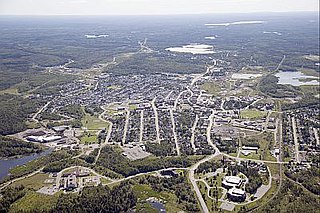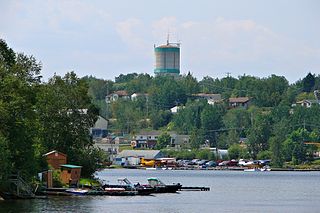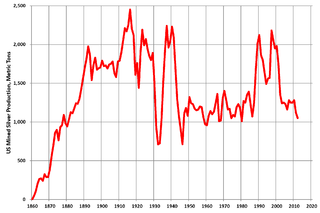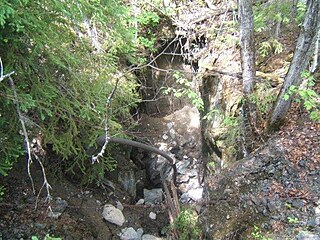
Kirkland Lake is a town and municipality in Timiskaming District of Northeastern Ontario. The 2016 population, according to Statistics Canada, was 7,981.

Temiskaming Shores is a city in the Timiskaming District in Northeastern Ontario, Canada. It was created by the amalgamation of the town of New Liskeard, the town of Haileybury, and the township of Dymond in 2004. The city had a total population of 9,634 in the Canada 2021 Census. Temiskaming Shores is Ontario's second-smallest city, in terms of population, after Dryden. Haileybury is the seat of Timiskaming District.

Cobalt is a town in Timiskaming District, Ontario, Canada. It had a population of 1,118 at the 2016 Census. The population is now closer to 943.
The Nipissing Central Railway (NCR), sometimes known as the Temiskaming Streetcar Line, is a former interurban streetcar system connecting New Liskeard, Haileybury and Cobalt on the western bank of Lake Temiskaming in northern Ontario from 1910 to 1935. As the line had a federal charter, the operating company continues to be used to operate the Ontario Northland Railway freight spur line between Swastika, Ontario and Rouyn-Noranda, Quebec, avoiding the need to re-charter either end in its respective provinces.

Unorganized Thunder Bay District is an unorganized area in northwestern Ontario, Canada in Thunder Bay District. It comprises all parts of the district that are not part of an incorporated municipality or a First Nations reserve.

The Hollinger Gold Mine was discovered on October 9, 1909, by Benny Hollinger, who found the gold-bearing quartz dike that later became known as Hollinger Mines. With his friend, professional prospector Alex Gillies, Hollinger had travelled to the Porcupine region in the wake of the Wilson expedition, which had recently discovered the future Dome Mine site. Hollinger and Gillies staked three claims each, and one for their former partner, Bernard "Barney" P. McEnaney, who had been unable to join them due to severe sciatica.

Red Lake is a municipality with town status in the Canadian province of Ontario, located 535 km (332 mi) northwest of Thunder Bay and less than 100 km (62 mi) from the Manitoba border. The municipality consists of six small communities—Balmertown, Cochenour, Madsen, McKenzie Island, Red Lake and Starratt-Olsen—and had a population of 4,107 people in the Canada 2016 Census.
Noah Anthony Timmins was a Canadian mining financier and developer who is now counted among the founding fathers of Canada's mining industry.

Devil's Rock is a granite escarpment located 5 kilometres (3 mi) south of Temiskaming Shores, Ontario, Canada. The cliffs rise 300 feet (91 m) above Lake Timiskaming and extend nearly as far underwater as they do above, giving Devil's Rock a cliff face roughly 600 feet (180 m) tall.

Silver mining in the United States began on a major scale with the discovery of the Comstock Lode in Nevada in 1858. The industry suffered greatly from the demonetization of silver in 1873 by the Coinage Act of 1873, known pejoratively as the "Crime of 73", but silver mining continues today.

The Porcupine Gold Rush was a gold rush that took place in Northern Ontario starting in 1909 and developing fully by 1911. A combination of the hard rock of the Canadian Shield and the rapid capitalization of mining meant that smaller companies and single-man operations could not effectively mine the area, as opposed to earlier rushes where the gold could be extracted through placer mining techniques. Although a number of prospectors made their fortune, operations in the area are marked largely by the development of larger mining companies, and most people involved in the mining operations were their employees.
Silver Centre is a ghost town in Timiskaming District, Northeastern Ontario, Canada, situated in South Lorrain Township. It is located approximately 35 km (22 mi) south of North Cobalt, and 3 km (1.9 mi) west of Highway 567. Silver Centre was a secondary camp to the great silver fields of Cobalt, discovered in 1903. There are no current residents in Silver Centre. It is still an active mineral field and does at times have active mineral exploration.

Beanland Mine, also known as Clenor Mine, is an abandoned surface and underground mine in Northeastern Ontario, Canada. It is located about 1 km (0.62 mi) west of Arsenic Lake and 4 km (2.5 mi) northwest of the town of Temagami in central Strathy Township. It is named after Sydney Beanland, who first claimed the mine site in the 1920s and was a director for the mine from 1937 to 1938.
The Nipissing Mine is an abandoned silver mine in Cobalt, Ontario, Canada, located on Nip Hill on the east side of Long Lake.

Big Dan Mine is an abandoned underground mine in Northeastern Ontario, Canada. It is located about 1 km (0.62 mi) southwest of Net Lake and just west of the Ontario Northland Railway in east-central Strathy Township. It is named after Dan O'Connor, who first claimed the site in the 1890s.

Keeley-Frontier Mine is a large abandoned mine in the ghost town of Silver Centre, Northeastern Ontario, Canada. It consists of two underground mines that were sunk 1,455 ft (443 m) below the surface. Keeley Mine was discovered in 1907 while Frontier Mine was constructed in 1921. The 8th level of the Keeley Mine connected with the 6th level of the Frontier Mine in 1962, creating the two compartment Keeley-Frontier Mine. In 1965, Keeley-Frontier Mine closed with a total production of 19,000,000 oz (540,000,000 g) of silver, 3,300,000 lb (1,500,000 kg) of cobalt, 27,000 lb (12,000 kg) of nickel and 10,000 lb (4,500 kg) of copper.
Priest Mine is an abandoned surface and underground mine in Northeastern Ontario, Canada. It is located about 19 km (12 mi) northwest of the hamlet of Marten River on an island in north-central Cross Lake. Dating back to the early 1900s, it is one of the oldest mines in the municipality of Temagami.
Henry Timmins was a Canadian shopkeeper who, with his younger brother, Noah, became an influential mining financier. The brothers are considered to be among the most significant founding fathers of the Canadian mining industry.
The Rabbit Lake Occurrence is a mineral showing near the southeastern shore of Rabbit Lake in Northeastern Ontario, Canada. Situated in northeastern Askin Township, the occurrence contains primary cobalt, nickel and gold mineralization but silver is also present. It has a width of 46 cm (18 in) and is hosted by a fracture zone in conglomerate-greywacke of the Huronian Supergroup.
Alfred "Fred" La Rose, also known as "Fred Rose" and "Frederick LaRose", was a blacksmith from Quebec who discovered silver on September 15, 1903 at the future site of Cobalt, Ontario. He is often referred to as the "Father of Cobalt," an unofficial title shared by the province of Ontario's first geologist, Dr. W. G. Miller.












